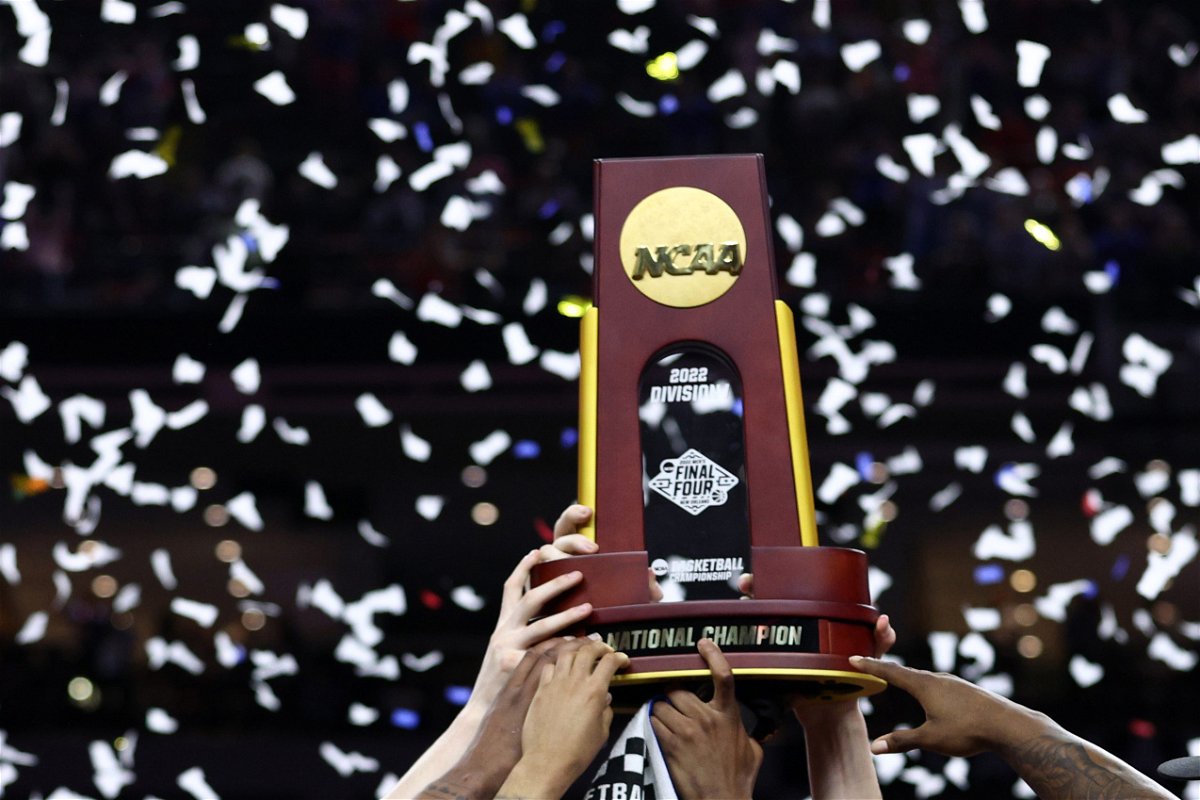2023 March Madness: Here’s all you need to know ahead of the men’s college basketball season’s crescendo

The Kansas Jayhawks celebrate with the trophy after defeating the North Carolina Tar Heels during the 2022 NCAA Men's Basketball Tournament National Championship at Caesars Superdome in 2022.
By Ben Morse, CNN
The conclusion of the men’s college basketball season is upon us and that can only mean one thing: it is time for the ‘Big Dance.’
March Madness has arrived and will pit the best of the best and some overachieving “Cinderellas” duking it out for an opportunity to be crowned the NCAA men’s Division I college basketball champion.
Having originally began in 1939 — with the women’s edition only added in 1982 — it has become a fixture of every sport fan’s calendar and is one not to be missed.
Not only has it become synonymous with shock results and upsets, March Madness has been the springboard for many successful NBA careers, including the Golden State Warriors star Steph Curry and Los Angeles Lakers big man Anthony Davis.
Here’s all you need to know about the crescendo to the men’s college basketball season.
Format
The process of whittling down 68 teams in Division I has pitfalls for teams around every corner.
The 32 automatic qualifying spots are filled by the teams which win each of the 32 conferences that make up Division I, while the other 36 will be selected to “at-large” berths by the NCAA Selection Committee.
The Selection Committee will reveal the “at-large” teams as part of the entire 68-team field on Selection Sunday, March 12.
The opening round of March Madness is called the “First Four” which sees eight teams — the four-lowest seeded automatic qualifiers and the four lowest-seeded at-large teams — playing in four games to decide the final spots of the bracket. The “at-large” teams face one another while the automatic qualifiers take on each other.
Once the 64 teams have been cemented, the first and second rounds of March Madness take place between March 16-19 across various venues in the US.
The next round of the tournament is the regional semifinals — colloquially called the “Sweet 16” — which sees the 16 remaining teams compete for a spot in the “Elite Eight” — the regional final round.
The four teams which make it to the “Final Four” will be the winners of their respective regional bracket.
This year’s “Final Four” round will take place on April 1 at NRG Stadium in Houston, Texas.
The two winners will advance to the NCAA championship game to be played at the same location on April 3, with the victor being crowned national champions.
Traditions
Since it was organized over 80 years ago, March Madness has become famous for some unique traditions.
Before the action gets underway, it is customary for fans and even non-hoops fans to fill out a single elimination tournament bracket — a process by which spectators try to predict the outcomes of every game, including the eventual winner.
The process has been something people from all walks of life have tried their hand at, from former US Presidents Barack Obama and George H.W. Bush to Jimmy Fallon.
You will also likely see coaches and players from the last team standing cutting down the nets on the court.
The act of cutting down the nets off a basket — thought to have originated in Indiana high school basketball in 1947 — has become synonymous with celebration, in particular of a championship victory.
There could be other points throughout the tournament where teams deem it worthy to cut down the nets, whether it be in the Final Four or the Sweet 16, but you will almost definitely see members from the 2023 national champions cutting the nets down at NRG Stadium and keeping threads as a souvenirs.
March Madness is also well-known for its propensity for shocking upsets.
The elimination element of the tournament lends it to unexpected results when higher seeds topple lower seeds. The unsung teams who topple notable programs are nicknamed “Cinderellas.” Over the years, there have been plenty to delight neutrals or to break the hearts of bracket fanatics.
Last year’s dream run came from unheralded Saint Peter’s. With an enrollment of 2,637 students, the university, located in Jersey City, New Jersey, caught the attention of all when it became the first No. 15 seed to reach the Elite Eight in NCAA tournament history, upsetting the No. 3 seed Purdue Boilermakers and No. 2 seed Kentucky the way.
From No. 16 seed UMBC Retrievers beating No. 1 seed Virginia Cavaliers in 2018 — becoming the first and only No. 16 seed to defeat a first seed — to Lehigh defeating college basketball powerhouse Duke — at the time, just the sixth win for a No. 15 seed over a No. 2 — upsets are part of the fabric of the annual madness.
Whether it is hoping for upsets, anticipating the drama, filling out brackets, or watching potential future NBA stars, March Madness has something for us all.
The-CNN-Wire
™ & © 2023 Cable News Network, Inc., a Warner Bros. Discovery Company. All rights reserved.
CNN’s David Close and Wayne Sterling contributed reporting.